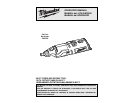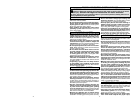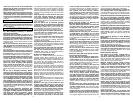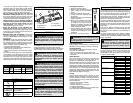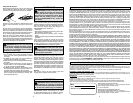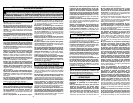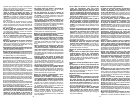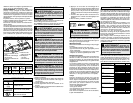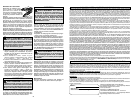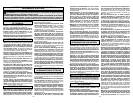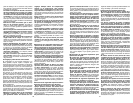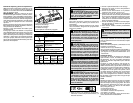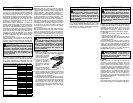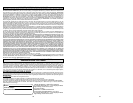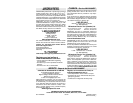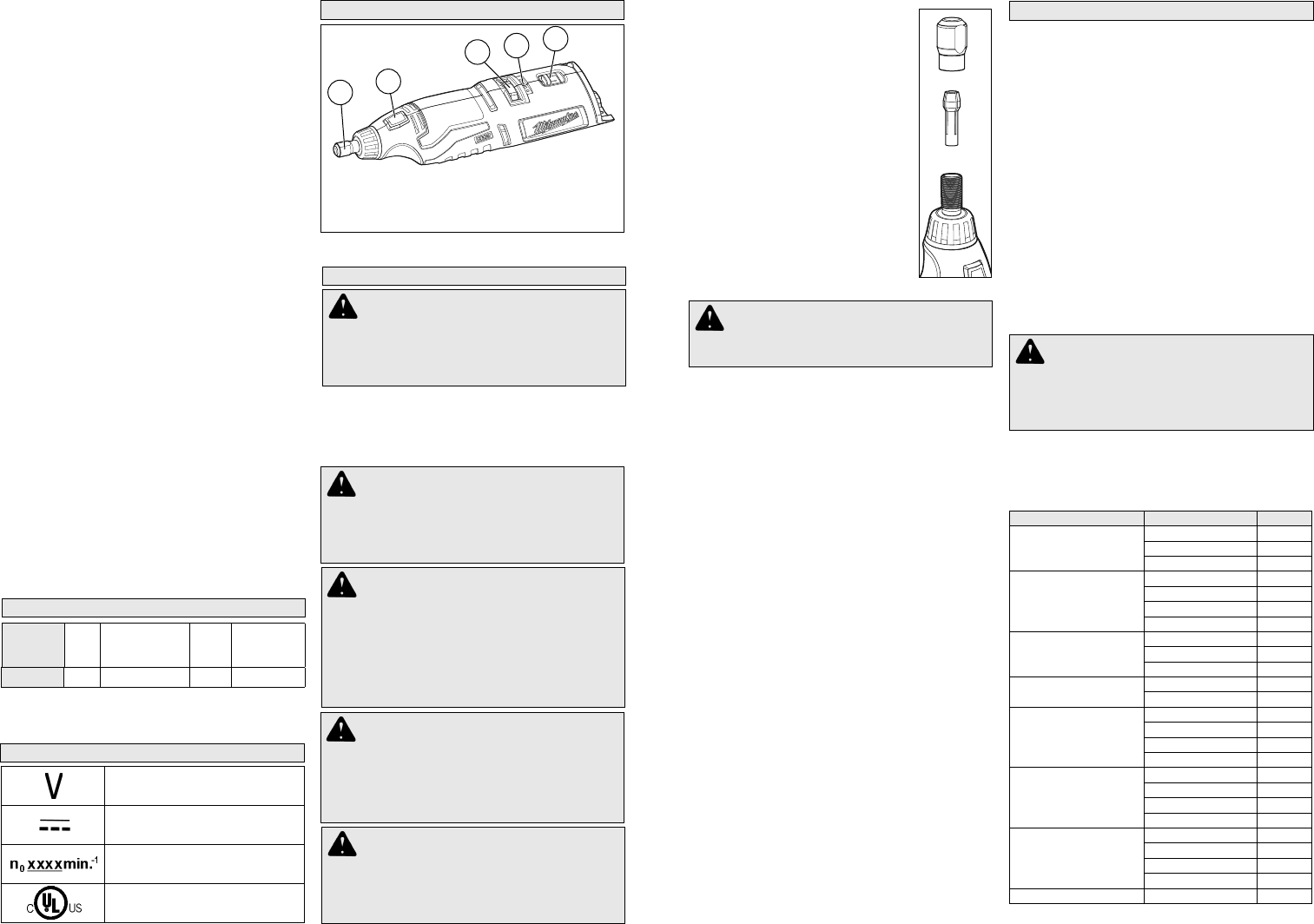
6
7
FUNCTIONAL DESCRIPTION
SYMBOLOGY
SPECIFICATIONS
Cat. No.
Volts
DC No load RPM Collet
Max.
Accessory
Diameter
2460-20 12 5000 - 32000 1/8" * 2"
ASSEMBLY
WARNING Recharge only with the
charger specifi ed for the battery. For specifi c
charging instructions, read the operator’s
manual supplied with your charger and bat-
tery.
Inserting/Removing the Battery
To remove the battery, push in the release buttons
and pull the battery pack away from the tool.
To insert the battery, slide the pack into the body of
the tool. Make sure it latches securely into place.
* accepts standard collet sizes 1/32", 1/16", 3/32", 1/8"
WARNING Always remove battery
pack before changing or removing acces-
sories. Only use accessories specifically
recommended for this tool. Others may be
hazardous.
WARNING To reduce the risk of injury,
always clean mandrels before inserting them
into the collet and securely tighten the collet
nut and. Otherwise the high-speed rotation
of the tool could force the accessory to fl y
out of the collet.
WARNING Only use accessories with
Maximum Safe Operating Speed rated at least
equal to the maximum speed marked on the
power tool. This speed is based on the strength
of the accessory, allowing for a reasonable
measure of safety. It is not meant to imply a
best or most effi cient operating speed. Do not
exceed the Maximum Safe Operating Speed.
WARNING Everyone in the area must
wear protective clothing and safety goggles
or face shields. Damaged accessories may
fl y apart with considerable force, causing
potential for serious injury.
1. Collet nut
2. Spindle lock
3. Speed dial
2
5
3
4
4. Fuel gauge
5. On/Off switch
1
in the groove, and can kickback. When a cut-
off wheel grabs, the wheel itself usually breaks.
When the steel saw, high-speed cutters or tung-
sten carbide cutter grab, it may jump from the
groove and you could lose control of the tool.
• Do not position your hand in line with and
behind the rotating wheel. When the wheel, at
the point of operation, is moving away from your
hand, the possible kickback may propel the spin-
ning wheel and the power tool directly at you.
• Allow brushes to run at operating speed for
at least one minute before using them. During
this time no one is to stand in front or in line
with the brush. Loose bristles or wires will be
discharged during the run-in time.
•Direct the discharge of the spinning wire
brush away from you. Small particles and tiny
wire fragments may be discharged at high veloc-
ity during the use of these brushes and may be-
come imbedded in your skin.
•Maintain labels and nameplates. These carry
important information. If unreadable or missing,
contact a MILWAUKEE service facility for a free
replacement.
•WARNING: Some dust created by power sand-
ing, sawing, grinding, drilling, and other construc-
tion activities contains chemicals known to cause
cancer, birth defects or other reproductive harm.
Some examples of these chemicals are:
• lead from lead-based paint
• crystalline silica from bricks and cement and
other masonry products, and
• arsenic and chromium from chemically-treated
lumber.
Your risk from these exposures varies, depending
on how often you do this type of work. To reduce
your exposure to these chemicals: work in a well
ventilated area, and work with approved safety
equipment, such as those dust masks that are spe-
cially designed to fi lter out microscopic particles.
Volts
Direct Current
No Load Revolutions per
Minute (RPM)
Underwriters Laboratories, Inc.
United States and Canada
Installing Accessories
1. Remove the battery pack.
2. Remove dust and debris from the
collet, collet nut, and accessory
shank.
3. Insert the collet into the spindle.
4. Loosely screw the collet nut onto
the spindle.
5. Insert the accessory shank into the
collet at least 3/4".
6. Press in the spindle lock button
and tighten the collet nut secure-
ly using the 3/8" collet wrench.
Note: Do not tighten the collet nut
without an accessory installed. This
could damage the collet.
7. Insert a battery pack and test the
accessory by letting it spin for one
minute before applying it to the
workpiece.
8. To remove, reverse procedure.
OPERATION
WARNING Always remove battery
pack before changing or removing acces-
sories. Only use accessories specifically
recommended for this tool. Others may be
hazardous.
Fuel Gauge
To determine the amount of charge left in the bat-
tery, turn the tool ON. The Fuel Gauge will light up
for 2-3 seconds. When less than 10% of charge is
left, 1 light on the fuel gauge will fl ash slowly.
To signal the end of charge, all lights on the fuel
gauge will fl ash quickly for 2-3 seconds and the tool
will not run. Charge the battery pack.
To prevent accidental starting, if the battery pack is
inserted when the tool switch is in the "ON" position,
all lights on the fuel gauge will fl ash twice and the
tool will not run. Turn the tool off, then back on to
begin work.
If the tool or battery becomes too hot, the fuel
gauge lights will fl ash in an alternating pattern and
the tool will not run. Allow the tool and battery to
cool down.
To protect against high torque, binding, stalling,
and short circuit situations, the tool will shut down
and all the fuel gauge lights will fl ash. Release the
trigger and restart.
WARNING To reduce the risk of injury,
the operator should be instructed in the use,
care and protection of accessories.
Typical Applications
A large variety of accessories are available for ap-
plications such as grinding, sanding, and cutting.
Grinding/Sanding
Use sanding and grinding accessories that are:
• less than 2" in diameter.
• correct accessory type and grit for the job.
• rated at or above the RPM listed on the tool's
nameplate.
Wheel Brushes
Wire wheel brushes are useful for removing rust,
scale, burrs, weld slag, etc. A wide variety of wire
brushes are available for many applications.
When applying brush to work, avoid using too much
pressure. This causes over-bending of wires and
heat build-up resulting in premature wire breakage,
rapid dulling and reduced brush life. Instead of using
more pressure, try a wire wheel brush with more
aggressive cutting action (increased wire size, de-
creased wire length or different brush type, i.e. knot
type instead of crimped wire type).
Cutting
Always handle cutting wheels carefully to avoid
damage. Before installing any wheel, always in-
spect it for cracks. If wheel is cracked, discard it to
prevent others from using it. Cutting wheels should
be protected from:
• wetness and extreme humidity
• any type of solvent
• extreme changes in temperature
• dropping and bumping
If a cutting wheel encounters any of these situa-
tions, discard the wheel immediately.
Accessory Material Speed
Grinding/Sanding point Wood 2
Steel 3
Aluminum 2
Steel cutters Wood 6
Plastic 2
Steel 2
Aluminum 3
Grinding stone Plastic 2
Steel 6
Aluminum 1
Wire brushes Steel 2
Aluminum 2
Polishing point Wood 1
Plastic 1
Steel 1
Aluminum 1
Cutting wheel Wood 6
Plastic 1
Steel 6
Aluminum 6
Drill bit Wood 6
Plastic 1
Steel 3
Aluminum 3
Router bit Wood 6
Selecting speed
To set the maximum speed, rotate the speed dial.
Set the speed dial to "1" for the lowest speed
(5000 RPM). Set the speed dial to "6" for the high-
est speed (32000 RPM).



